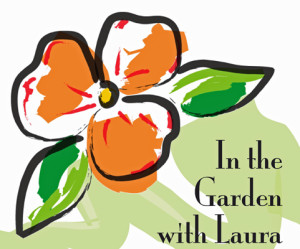 “Snow birds” aren’t the only birds to flock to Florida in winter. So, when my husband and I recently visited Vero Bea
“Snow birds” aren’t the only birds to flock to Florida in winter. So, when my husband and I recently visited Vero Bea
ch, we went birding.
One of our stops was the Pelican Island Audubon Society. The visit wasn’t what I expected. I thought I’d see trails an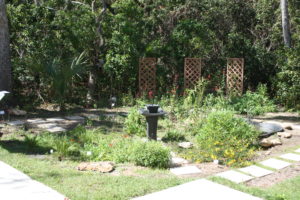 d birds. Instead, there were plants and people. The people were enthusiastic, knowledge and so friendly that I was ready to become a volunteer.
d birds. Instead, there were plants and people. The people were enthusiastic, knowledge and so friendly that I was ready to become a volunteer.
The Gardens
One of the people we met was Ken Gonyo, Pelican Island’s volunteer coordinator. A volunteer himself, he gave us a tour of the gardens, which he designed.
The gardens in front of the society’s two buildings have a formal style, reflecting the tastes of many home gardeners. It becomes less formal the further into the grounds you walk.
In the back, there is a lovely butterfly garden recently created by Gonyo. His focuses on butterflies for two reasons: he loves them and they are an effective way to introduce students to nature.
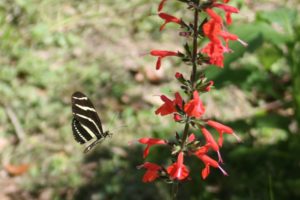 The garden features native plants. Tropical sage, Salvia coccinea, attracts Florida’s native Zebra longwing butterflies, Heliconius charitonia. The flower’s range extends from southeastern Canada through the eastern and southwestern United States and part of south America. They are a wonderful addition to any garden in the Northeast.
The garden features native plants. Tropical sage, Salvia coccinea, attracts Florida’s native Zebra longwing butterflies, Heliconius charitonia. The flower’s range extends from southeastern Canada through the eastern and southwestern United States and part of south America. They are a wonderful addition to any garden in the Northeast.
 Among the other Florida natives in the garden: Common Spiderworth, Tradescantia; and wild Coffee, Psychotria nervosa. They also have Giant leather ferns, Acrostichum danaeifolium, that have yet to reach their mature height of 12’ tall by 5’ wide.
Among the other Florida natives in the garden: Common Spiderworth, Tradescantia; and wild Coffee, Psychotria nervosa. They also have Giant leather ferns, Acrostichum danaeifolium, that have yet to reach their mature height of 12’ tall by 5’ wide.
The backyard also has a small native wetlands garden. It contains three native lilies saved from the original site as well as milkweeds, Asclepias; two species of swamp milkweeds, Asclepias incarnate; and a Scarlet Rose Mallow Hibiscus, Hibiscus coccineus.
The trees bordering the garden are home to orchids, Orchidaceae; ferns, Tracheophyta; bromeliads, Bromeliaceae, and Spanish moss, Tillandsia usneoides.
Nightly Visitors
The garden includes a bird bath and pond. Rigged with infrared lights, the pond has a motion-sensitive camera to take photos of any evening visitors. There has been quite a parade. Raccoons jumped in the pond and swam around. Opossums, rabbits and squirrels have visited and even a six-foot Black Racer snake has explored the watering hole, said Gonyo.
A birdfeeder surrounded by a cage was built for the benefit of Painted buntings. They love millet but don’t like other birds near them when they eat. Audubon volunteers built them their own special feeder designed to keep away other birds and squirrels. None had been sighted as of late February but the society is ready for them when they do arrive.
A hike was planned for the next day so we headed out with plans to return.
The Society’s Mission
On our return trip, we met the President of the Pelican Island Audubon Society, Dr. Richard Baker. An entomologist who retired the University of Florida, he shared his wealth of knowledge about birds, plants and the area’s wild life.
He also succinctly stated Pelican Island’s mission: “The most important way we can benefit birds, is to preserve their environment.”
To achieve that goal, the society built two buildings in a 440-acre sanctuary. The land, which the Indian River County owns, is cooperatively cared for by the Indian River County, University of Florida and the Audubon Society, which maintains and creates the trails in the sanctuary.
One of the major issues facing the area is a loss of sea grass by the coastal areas and fish kills.
Hammock and Scrub Pines
A road divides the sanctuary in two. On one side is scrub, on the other hammock, two of southern Florida’s native forests. Ken Gonyo took us on a hike through the hammock portion of the forest. The scrub would have to wait for another trip!
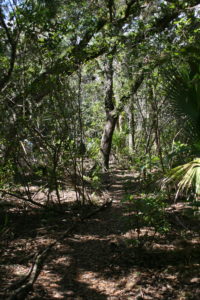 The hammock in Southern Florida consists of a canopy of oak trees and cabbage palms that create a shady forest.
The hammock in Southern Florida consists of a canopy of oak trees and cabbage palms that create a shady forest.
As we headed into the hammock, we came upon a sunny abandoned citrus grove. The citrus trees were long gone. The field had become a Florida-style meadow with grasses and weeds growing with abandon. As we walked deeper into the woods, it quickly became shadier.
Ferns and palm trees surrounded by lush growth offered a peaceful yet distinct mood that was distinct from forests further north.
We continued along the path until we crossed a rickety bridge over a small stream to see an eagles’ nest. We could see the nest. If the eagle was in it, however, it had hunkered down too far to confirm a sighting with any confidence.
Air Potatoes
Weeds in Florida make their northern counterparts seem tame in comparison.
While we were hiking, volunteers had arrived for the third annual Air Potato Roundup. They scoured the woods for the infamous air potato, Dioscorea bulbifera.
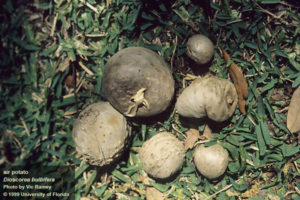 Toxic and highly invasive, this member of the Yam family, can grow to 70’ or more. It reproduces by dropping brown “air potatoes” or bulbils. They range in size from small marbles to softballs. Once they begin growing, they can engulf native vegetation by climbing into mature tree canopies, according to the University of Florida Extension.
Toxic and highly invasive, this member of the Yam family, can grow to 70’ or more. It reproduces by dropping brown “air potatoes” or bulbils. They range in size from small marbles to softballs. Once they begin growing, they can engulf native vegetation by climbing into mature tree canopies, according to the University of Florida Extension.
The trick is to remove the bulbils or “potatoes” before they send out tubers and sprout new vines.
Picking up four baseball-size “potatoes” was the easiest and most satisfying weeding I have ever done. If I was faced with a forest full of these Asian and African imports, however, I might not be so enthusiastic.
We finished our hike and returned to the butterfly garden. We were greeted by more volunteers who were overseeing the assault on the air potatoes. The enthusiasm and cheerfulness of everyone present was impressive.
 In addition to gaining a greater appreciation of southern Florida’s flora and fauna, I learned about a wonderful organization and the people who make it tick. Anyone who is in the area couldn’t look for a better way to spend some time.
In addition to gaining a greater appreciation of southern Florida’s flora and fauna, I learned about a wonderful organization and the people who make it tick. Anyone who is in the area couldn’t look for a better way to spend some time.
For more info check out their website: 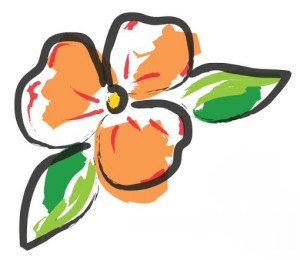 http://www.pelicanislandaudubon.org/
http://www.pelicanislandaudubon.org/
Laura
